I have traveled to other parts of Colorado in the past years, that will be included on this
site in the future. Please Bookmark this site as it will be changing often.
The early miners had a very rough life many died of snow-slides, cave-ins, fires,
sicknesses and gun shots. The colorful language on tombstones, in the Hillside Cemetery tell of the many ways
the miners died. A book by Freda Carley Peterson "The story of the Hillside Cemetery" tells about
most, if not all of the residents in the cemetery. There were a few outlaw gangs in the area that
robbed banks in New Mexico, then ran to Colorado until it cooled off. The Stockton Gang was a
prime example of this. William Porter ("Port") Stockton (1853-1881) and his brother Ike
bounced from Silverton, Colorado to Farmington, and Bloomfield, New Mexico robbing banks in the 1870's.
"Port" even reportedly bragged that he rode with Billy the Kid's gang, in the Lincoln County War, in
New Mexico. The local gangs also included Clay and Charley Allison, Harg and Dice Eskridge at
one time. The enterprising individuals branched out to cattle stealing as well. Taking the stolen
cattle from New Mexico to Colorado and vice versa. The main social activities in Silverton were
dances, benefits, and baseball. The town council hired famed lawman Bat Masterson as Sheriff to
attempt a closure to the notorious Blair Street's 40 saloons and gambling dens, as well as the
brothels. The attempt failed and Bat Masterson moved on west. I read that the people of Animas
City, Colorado, (now the north end of Durango, Colorado), hired Port Stockton as town Marshal for a time.
So I guess that Port Stockton was a man of many talents.
I retired from the Farmington Police Department (Farmington, New Mexico) in September
of 1997, I couldn't pass up the photo of the hanging man, and the old jail. I also included the first
jail in San Juan County, Colorado. The photo of the first jail and the newer, (closed) jail/museum
show the changes over the years. Now the prisoners have to be transported 24 miles to Durango,
Colorado.

THE DURANGO & SILVERTON NARROW GAUGE RAILROAD
When in Durango and Silverton, a must see attraction is the narrow gauge railroad.
The trip, (either way) is an adventure that will stay with you forever. The scenery is breath taking and
if you look closely the wildlife may come out and greet you. There are many deer and elk in the
area, so you have to watch for them. The book "Cinders & Smoke" by Doris B.
Osterwald, is loaded with facts about the Durango & Silverton Narrow Gauge Railroad. When
you ride the train, I would suggest that you follow along with the guide book for information on
the route and facts on how it was built. The book also is great for the train enthusiasts. The most
impressive view on the trip is in Cascade Canyon, the trail had to be cut in to the mountain. The
view to the river below is breath taking. Imagine the workers hanging on ropes to cut out the
rock. The depot in Silverton was renamed "Epitaph" in the 1949 movie "Ticket to Tomahawk".
The Silverton edition was built in 1881-1882 by the Denver & Rio Grande Railways
company. The Denver & Rio Grande Railroad was formed in Denver in 1870. The branch from Alamosa was abandoned in 1951.
The branch from Durango, Colorado to Farmington, New Mexico was dismantled in the early
1960's. Highway 550 between Durango and Farmington still has the remnants of the railroad
right of way, with bridges and some tracks. The old train station in Farmington was turned into storage building, and later
several other businesses. This large building is still standing and is located on the north west corner of Elm and Behrend streets.
There were several levels in this building for maintence, equipment, and parts storage. I was involved in a
search of this building in 1982 as a police officer, and I believe there were two or three sub-levels.

ANIMAS FORKS TRIP FROM SILVERTON
The largest and most popular ghost town in the area, is Animas Forks. The trip can be made with the
family car on this gravel county road, but be careful of rocks in the road. A rock through the oil
pan can ruin a day.
County Road 110 is located on the north end of Silverton near the Hillside Cemetery. The
road branches east and west. On this trip we will be traveling east then north. This route parallels
the right, of the old railroad right of way. The first point of interest can be seen in the distance and
off to the right (east), it is the Luckawanna Mill & Mine just across the Animas River. The mine
and mill are privately owned and are worked in the summer by the owner. First you will see
hundreds of mines in the mountain side as well as the yellow tailing piles in front of them. The
a large building, as we come into town on the left it is the Mayflower Mill. The ore carts on the cable still
cross the road. Materials and workers traveled the skyway between the mines and the mill.
There is a tour of this Mill that must be seen for an insight on the processes involved in refining the ore.
The next site that we come to is the a red brick building that was once the local power station. Around the bend and up
the valley is Howardsville.

HOWARDSVILLE (Bullion City)
Bullion City was established in 1874 and was soon renamed for George W. Howard.
George Howard was the first permanent resident, when he returned from the Civil War and built
the first cabin in the town in 1872. Howardsville reached a population of about 2,500 with as
many as 75 houses. Howardsville has the honor as having the first county seat and post office in
western Colorado. They were established in 1874. The post office and county seat changed to Silverton the following
year. Most of the buildings and stores were later moved to Silverton.
As the road makes a turn to the right the old cable house can be seen. The cable house
provided ore and equipment and transportation to the mill in Howardsville. The cables were
taken down for safety. The road forks off to the right and heads up Cunningham Gulch to the Old
One Hundred Mine and tour. We will continue north and soon there will be
a wide spot in the road with a collapsed structure on the right. This is where the former town of
Middleton once stood. Further down the road as the valley opens is where the town of Eureka
stood.

EUREKA
All that remains of the town of Eureka are some foundations and a ruin of the mill on the
east hillside. The Sunnyside Mining Company was started 1873 in Eureka then moved to
Gladstone, (on the other side of the mountain) several years later. Refer to "Silverton Gold" by
Allen Bird for the story of the Sunnyside Mining company. Otto Mears brought his Silverton
Northern Railroad to Eureka in 1896. The area is now a great camping area for gold panning and
scenery. The road that winds up the west face of the mountain once lead to the other side of the
mountain and Gladstone. The road is blocked by a fence put up by the mining company. County
Road 110 continues north toward Animas Forks. On the right as the road climb is the old
boarding house. The boarding house was reconditioned and used as a home for the outward-bound people for several years.
The outward-bound program took Juveniles with legal and
behavior problems and turned them around. The program was canceled for the boot camp
programs of today. There is a snowshed on the left side of the road which was built by Otto
Mears to protect the train tracks from slides. The shed still stands however the snow traveled
over the top of the shed and would cover the tracks anyway so it was a failure. The road passes
several mills and mines on both sides of the road on the way as well as the beautiful scenery.
The road continues until finally the valley widens and you can see
the town of Animas Forks. On
the far mountainside the 4x4 road that climbs up the mountain then to the right is Cinnamon Pass
to Lake City. The first part of that road continues straight to the north and becomes the Engineer
Pass road.

ANIMAS FORKS
The town of Animas Forks is now in view, but the concrete foundation by the road is the
remains of the old mill. The building was also used to hold dances and other get together
There are still several buildings to explore and photograph. Every year the heavy winter
snowfalls take their toll on the old buildings. Animas Forks once boasted of a population of 400
people. Prospecting began in this area began around the 1870's. An Animas Forks judge once told
a defendant that his decisions could not be appealed, as this was the highest court in the land. The
elevation is 11,300 to 11,400 and the surrounding mountains are 13,000 feet. The other smaller
towns or communities in the near area are Mineral Point, (only a site) to the north via Engineer
Pass, and Lake City. The large two story house on the north end of town has been reported to
have been owned by Thomas Walsh of the Camp Bird Mine fame. The other photo is of the walls
of the old jail. Note the 2x4's laid flat to restrict an easy escapes.
There is a 4x4 road on the north side of the town that leads to the west up the California
Gulch which leads to the Bagley Mill stamp mill built in 1913. The road forks to the south and
heads back by another route (4x4), to County Road 110 at the Picayne Gulch Road, and also to
Hurricane Pass down to Hwy. 550.
The Engineer Pass route divides. The road to the west travels back to U.S. hwy. 550 via Mineral
Point. The road to the right leads to Lake City and very impressive scenery.
END OF THE ANIMAS FORKS TRIP



More Colorado Ghost Town Links

CONTACT US

| or Sign My Guest BOOK
|

|
Larry Miller - hamnut@sisna.com - KB5ITT
Designed by Gary Miller - garymiller@uswest.net
Designed by a member of


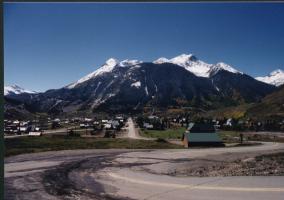



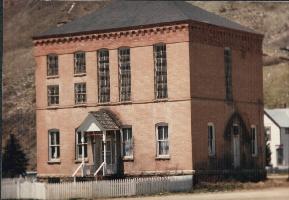



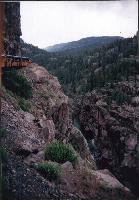

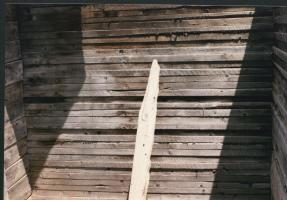



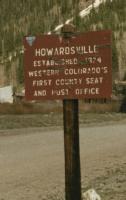

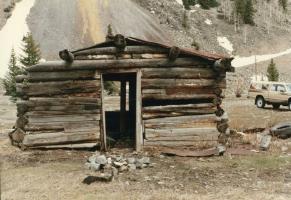

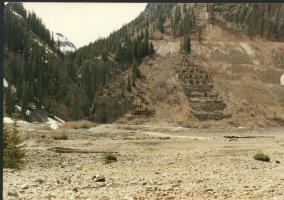


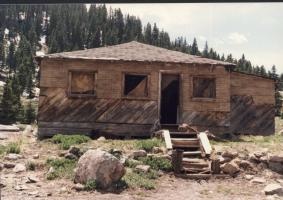


![]()

